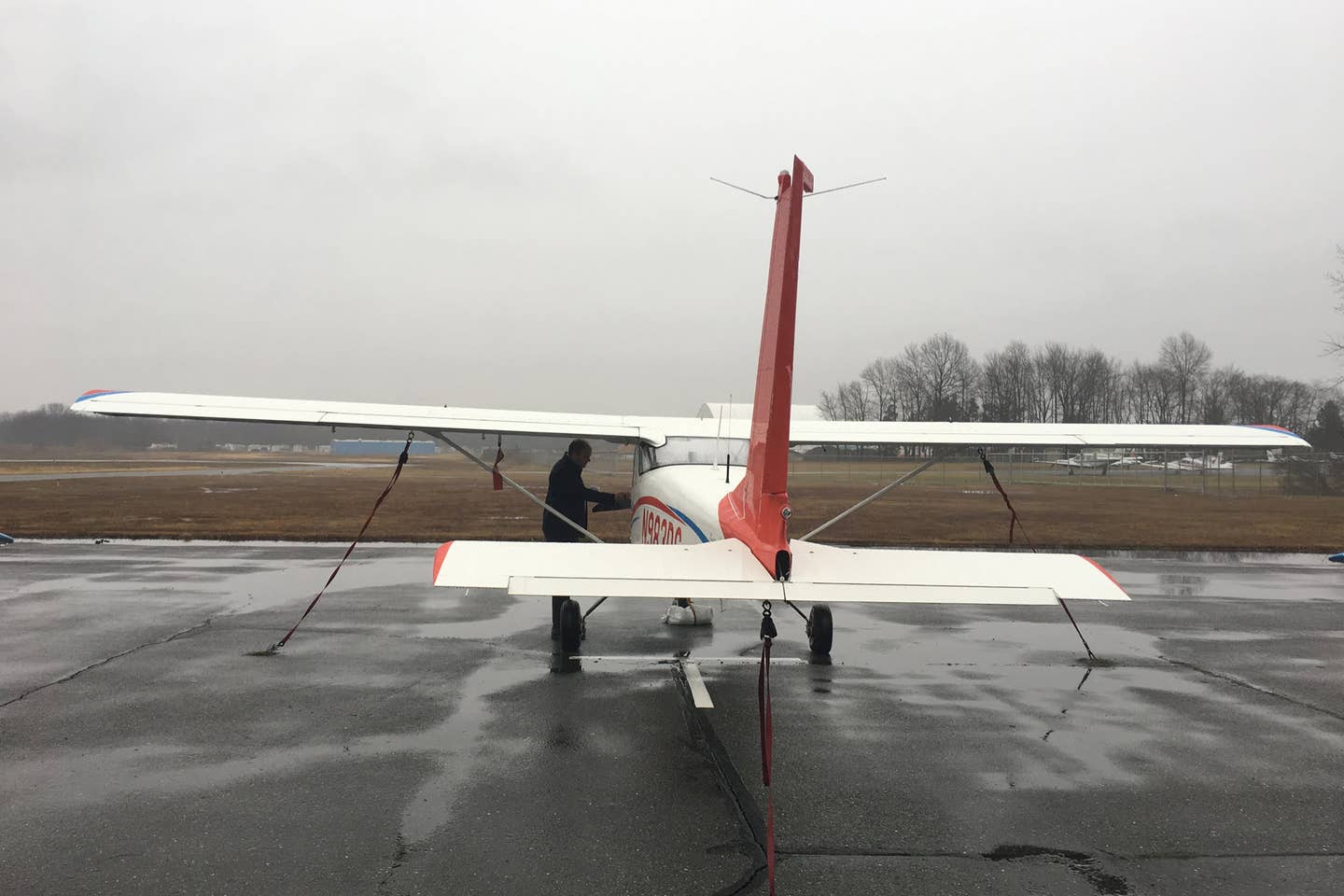
Getting your instrument rating can turn no-fly days into flyable ones. Julie Boatman
What goes before that, in planning and training, determines what kind of instrument pilot emerges from the process. Here we want to go through what it takes to produce the best and most complete instrument-rated pilot.
When we were writing about learning to fly, it was suggested that a private pilot course should be completed before starting training to get an idea of what is coming. That is an equally good idea before you begin instrument training. This is a far more complex endeavor and a pilot needs to go through an instrument rating ground course to get a feel for that complexity. An inexpensive PC airplane program, like Microsoft Flight Simulator or X-Plane (both available from Amazon), might also help in scoping out what is involved. These are not flight training devices but they can be useful in looking at procedures. An advance look at instrument training and flying might make it seem like the greatest and most fun challenge you can find, or it might seem a bit much. If the latter is the case, you might want to fly VFR for a while and then revisit the instrument course.
When contemplating an instrument rating some thought needs to be given to the risks found here. Some years ago, VFR weather-related accidents outnumbered IFR weather-related accidents by a lot. That has now reversed and many more weather accidents are found in IFR flying. Maybe there is more IFR flying, or maybe VFR pilots are doing a better job of risk management. Whatever the reason, the potentially high level of risk is something to think about before taking the IFR plunge.
More than half the pilots eventually get an instrument rating but only a small percentage of those maintain instrument currency. One association president said a while back that only 15 percent of its instrument-rated members were instrument current. That gives pause, and when you are contemplating the training it is best to know in advance what kind of instrument pilot you want to be. If you want to be one in name only, then all the training needs to do is get you through the check ride. If you want to be an active instrument pilot and not be a ready victim of the risks, then you need to go well beyond the basic requirements.
Instrument flying is a serious business. It is demanding. It takes active thinking. When a pilot gets the instrument rating he is authorized to evaluate weather, dispatch the flight, and is then challenged to fly the airplane in the same air traffic control system and weather systems that the two-crew turbine airplanes are using. The day after the rating is earned, a pilot is free to fly IFR to Atlanta Hartsfield on a dark and stormy night with passengers.
The colleges, universities and flight academies are doing a good job of teaching young pilots how to be airline first officers. The excellent safety record in regional airline flying is a tribute to the fine work being done here. Most pilots with a full-time job can't devote continuous time to training. And they are training for the more difficult job of starting out as a single-pilot captain. A smaller ship, to be sure, but the clouds and the hard ground don't know that. The record here is not so good.
This means that choosing a method of training needs to be done carefully.
One of the first things to determine is if the school really believes in flying light airplanes in clouds. There are three important questions to ask: "Will we fly actual IFR in training?" and, "Will some of the training take place at night?" plus, "After I get my instrument rating will you rent me airplanes for actual IFR flights?" The night part is important because the accident rate in night IFR is terrible and there is no night IFR training requirement. If you are training in your own airplane only the first two questions would be applicable. Another thing to resolve relates to the instrument panel in the airplane: glass or steam gauges?
This depends, at least partially, on what you will be flying after you complete the training. However, that is not something that should be cast in stone. It is my opinion that the training would best be done in a glass cockpit airplane because everyone who uses airplanes for purposeful transportation will eventually be flying a glass cockpit, so why not train there? It would probably be simpler to do it with steam gauges, if that is what you have been flying, but the glass is a nice challenge and once you learn it there is so much more capability there. Certainly if you learn in one you can transition to the other, but that will take some effort.
Next, you want to find out if IFR is taught as IFR is flown. Is autopilot use integrated into the training? Is the GPS navigator taught and used to the maximum extent possible? Does the school have a flight training device that can be used for familiarization with procedures before flying them in the airplane? Does the school have a relatively stable instructor group?
Once the school is vetted you have to become comfortable with an instructor. In the big and formal schools they have a system of checks and balances that ensures good progress through the course. When you are doing this at an FBO or local flight school it is more likely to be between you and one instructor, with maybe some checks along the way, and, at the end, the pilot examiner who will decide if the job was done well enough for him to give you the rating.
The great majority of the instructors at local flight schools are young people who are building flying time and sending resumes to airlines. On the surface this might seem like a bad deal for the trainee but that doesn't have to be the case. If these instructors are really interested in and enthusiastic about instrument flying, they can be good teachers of the art. There is some incentive for them here because most would much rather teach instrument than basic flying.
Because weather is such an important part of instrument flying you do want an instructor who has an abiding interest in helping you learn as much as possible about weather.
Weather and VFR flying is a pretty simple subject. VFR means visual, which means staying out of clouds and areas of poor visibility. There is a lot of black and white there. Weather for IFR flying is shades of gray. There we fly in the weather, not outside the weather, and weather wisdom is many times more important. It is actually critical, and learning as much as possible about weather is equally as important as the other elements of instrument flying. There are pilots who think they can be spoon-fed weather for IFR flights by an FSS, but these are the folks who get into weather trouble.
It would be nice if we could think that passing the FAA's knowledge test gets us where we need to be on weather. That is simply not the case. Weather for instrument flying is a much deeper subject and this is something you want to explore in depth with a potential instructor. Weather is one reason you want to find an instructor who will fly in actual conditions on training flights. If, in training, you do not plan and fly flights in actual weather, you won't have any way of knowing about the correlation between the information you get in a weather briefing and actual weather conditions. Remember, if you don't want to be a rated pilot who actually flies instruments, this isn't necessary. But if you want to be the real thing you have to plan on training in the real world.
A good way to examine the potential value to you of an instrument rating is to vicariously fly flights. Check the weather to see if you could fly a hypothetical flight in VFR conditions. If the answer is "no" then study the weather for a hypothetical IFR flight between the two points. A lot of weather elements affect IFR flights. There are clouds, ice, turbulence, precipitation, convection, fog, low ceilings, low visibilities and wind aloft to contend with. Only through study and actual flying can you put the proper weight on each of the elements that might affect your flying.
If all that makes it sound complex and demanding, good. According to the FAA, a pilot can get an instrument rating with 125 hours of flying time. That might be okay for a full-time student who wants to go on to become an airline first officer. But for a person who wants to fly single-pilot IFR in light airplanes, the FAA requirements are inadequate. If a pilot makes up his mind that he wants to learn how to stay alive while operating IFR it’ll take a lot more time, a lot more effort and, yes, a lot more money. Is it worth it? Only if you plan to use it.

Sign-up for newsletters & special offers!
Get the latest FLYING stories & special offers delivered directly to your inbox






